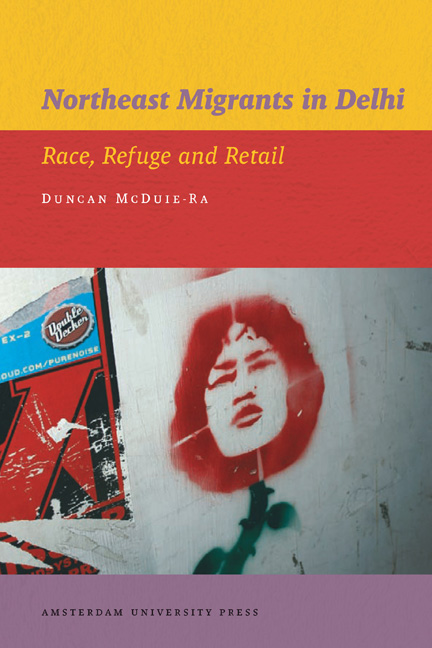Book contents
- Frontmatter
- Contents
- List of Maps and Images
- Acknowledgements
- Maps
- 1 Introduction
- 2 Leaving the Northeast
- 3 Coming to Delhi
- 4 Backward, Head-hunter, Sexy, Chinky
- 5 Provincial Men, Worldly Women
- 6 Place-making in the City
- 7 Conclusion
- Short Biographical Note on the Author
- Bibliography
- Index
- Publications Series
2 - Leaving the Northeast
Published online by Cambridge University Press: 14 January 2021
- Frontmatter
- Contents
- List of Maps and Images
- Acknowledgements
- Maps
- 1 Introduction
- 2 Leaving the Northeast
- 3 Coming to Delhi
- 4 Backward, Head-hunter, Sexy, Chinky
- 5 Provincial Men, Worldly Women
- 6 Place-making in the City
- 7 Conclusion
- Short Biographical Note on the Author
- Bibliography
- Index
- Publications Series
Summary
Northeast India is on the far eastern frontier of India. It is the ultimate borderland, barely connected to the rest of India and sharing international boundaries with five other nation-states. The frontier is located in the Indian national imaginary as distant, violent, and backward. Its people, especially in the hill areas, are racially distinct from the Indian mainstream, even when accounting for India's diversity. Different tribal and ethnic groups in the Northeast have pursued secessionist and autonomy struggles in the six decades since Indian independence. The region's government, development, and everyday life are militarised, and policy is orchestrated through national security priorities. In the second half of the 2000s, more people had begun to leave the frontier for other parts of India than ever before. This is not simply a steady increase; migration out of the frontier has multiplied many times over in a dramatically short period. This chapter examines the catalysts for migration out of the frontier. I make a two-fold argument. First, decades of insurgency and counter-insurgency have resulted in a militarised society in much of the Northeast region, which is a major catalyst for migration to other parts of India. Second, while very valid, the over-whelming focus on militarisation ignores the ways the dynamics of migration and the demographic profile of migrants have shifted in the last decade. These dynamics reveal a far more complex everyday social, economic, and political reality among the people leaving the region.
The Making of the Frontier
Conceptualising the Northeast as a singular territory is problematic and something many scholars from the region seek to actively avoid. However, in this chapter it is necessary to utilise the concept of the Northeast as a singular region because this construction determines the way the region is governed by the Indian state and underpins a shared identity among peoples from the various parts of the region, especially when they migrate to cities like Delhi.
A region this diverse, geographically varied, and historically contested can be discussed using a raft of different focal points. However, I will limit my discussion to three main components of the region's past and present: the category tribe, colonial encounters, and insurgency.
- Type
- Chapter
- Information
- Northeast Migrants in DelhiRace, Refuge and Retail, pp. 35 - 60Publisher: Amsterdam University PressPrint publication year: 2013



